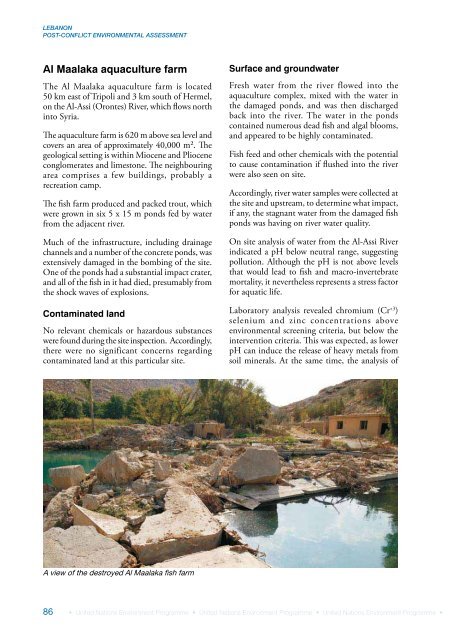Lebanon Post-Conflict Environmental Assessment - UNEP
Lebanon Post-Conflict Environmental Assessment - UNEP
Lebanon Post-Conflict Environmental Assessment - UNEP
You also want an ePaper? Increase the reach of your titles
YUMPU automatically turns print PDFs into web optimized ePapers that Google loves.
LEBANONPOST-CONFLICT ENVIRONMENTAL ASSESSMENTAl Maalaka aquaculture farmThe Al Maalaka aquaculture farm is located50 km east of Tripoli and 3 km south of Hermel,on the Al-Assi (Orontes) River, which flows northinto Syria.The aquaculture farm is 620 m above sea level andcovers an area of approximately 40,000 m². Thegeological setting is within Miocene and Plioceneconglomerates and limestone. The neighbouringarea comprises a few buildings, probably arecreation camp.The fish farm produced and packed trout, whichwere grown in six 5 x 15 m ponds fed by waterfrom the adjacent river.Much of the infrastructure, including drainagechannels and a number of the concrete ponds, wasextensively damaged in the bombing of the site.One of the ponds had a substantial impact crater,and all of the fish in it had died, presumably fromthe shock waves of explosions.Contaminated landNo relevant chemicals or hazardous substanceswere found during the site inspection. Accordingly,there were no significant concerns regardingcontaminated land at this particular site.Surface and groundwaterFresh water from the river flowed into theaquaculture complex, mixed with the water inthe damaged ponds, and was then dischargedback into the river. The water in the pondscontained numerous dead fish and algal blooms,and appeared to be highly contaminated.Fish feed and other chemicals with the potentialto cause contamination if flushed into the riverwere also seen on site.Accordingly, river water samples were collected atthe site and upstream, to determine what impact,if any, the stagnant water from the damaged fishponds was having on river water quality.On site analysis of water from the Al-Assi Riverindicated a pH below neutral range, suggestingpollution. Although the pH is not above levelsthat would lead to fish and macro-invertebratemortality, it nevertheless represents a stress factorfor aquatic life.Laboratory analysis revealed chromium (Cr +3 )selenium and zinc concentrations aboveenvironmental screening criteria, but below theintervention criteria. This was expected, as lowerpH can induce the release of heavy metals fromsoil minerals. At the same time, the analysis ofA view of the destroyed Al Maalaka fish farm86 • United Nations Environment Programme • United Nations Environment Programme • United Nations Environment Programme •
















